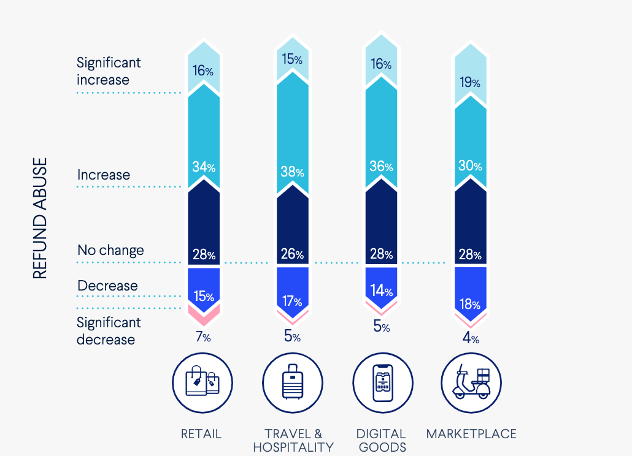Over 50% of online merchants are seeing an increase in refund abuse, as customers take advantage of easy returns and extended refund periods. Here’s what’s behind the increase...
Let’s talk about 2020. Covid-19 created a wave of unprecedented challenges for businesses across the globe. But with lockdowns and social distancing, eCommerce boomed. At the height of UK restrictions, online retail orders skyrocketed by up to 200%.
In 2022 as lockdowns ease and some countries get back to business-as-usual, it looks like the eCommerce frenzy isn’t going anywhere. Merchants are embracing a digital future and catering to the customers who have adapted to shopping online for good.
While online business is still soaring, so is refund abuse; and 51% of merchants are seeing an increase. Once seen as an accepted cost of doing business, refund abuse has become too pervasive to ignore.

What is refund abuse?
Refund abuse definitions can be confusing: is a customer trying to game refund terms and conditions to their advantage, or are they just trying to find the perfect pair of jeans?
Refund abuse (aka. returns abuse) occurs when a customer uses the returns policy of a merchant so much that they become unprofitable. Customers may also abuse refunds by faking returns/receipts or reselling merchandise. This is mainly carried out by genuine customers pushing their luck. Refund abuse is not strictly considered to be fraud, and chargebacks are not involved. Nonetheless, it is a problem.
Why is there a spike in refund abuse now?
The impact of Covid-19 on shopping conditions
The global pandemic meant online businesses had to scale up delivery services to cope with demand, offering incredibly generous refunds policies. It’s a savvy move as 83% of shoppers say they will only buy from brands with return policies they like, but easier returns policies create more opportunities for refund abuse.
Contactless delivery
During the pandemic, doorstep deliveries became essential, keeping staff and customers at a safe distance. The success of these deliveries was often hard to confirm, though; and customers could say they never received the goods (even if they did) to claim a refund.


Huge returns chains
‘Buy, pick up, and return anywhere’ systems have become standard. Retail giant ASOS has return drop-offs in over 47,000 locations in the UK. Whilst these are convenient services, their networks are so vast that returns become hard to track. Factor in a dwindling workforce, and it becomes clear why refund abuse can easily slip through the net.
Refund abusers can further take advantage by returning low-cost fakes instead of genuine merchandise. Apple once accepted a return for an iPhone that was actually a carefully weighed potato.
Extended returns periods
Many online merchants extended returns periods drastically to account for covid-delivery delays and to mimic the ‘try before you buy’ in-store experience. Long return periods tempt customers to bulk buy and serially return.
Social media and the serial returner
Wardrobing
A new wave of serial returners are ‘wardrobing’ on Instagram. Customers buy new outfits to wear once, take a selfie, and return the clothes soon after. ASOS was hit so badly by this behavior they took to trawling the internet to spot one-time wearers, blacklisting the thrifty fashionistas.
Since over a quarter of returned inventory cannot be easily resold and there’s no such thing as ‘free’ delivery for merchants, the costs are huge.
Viral refund hacks
Refund abuse has gone viral, as customers brag about their money-saving life-hacks on social media. US marketplace Wish.com was marked as an easy target on Reddit, and one TikTok user spread the news, posting a refund-method video that now has over 9,000 views.


Why would genuine customers abuse refunds?
Most refund abusers are not malicious, they are just opportunistic. Here’s why genuine customers keep abusing returns:
- Entitlement: customers feel entitled to refunds and don’t think about the costs.
- The Robin Hood effect: they think big corporations can afford to bear the costs forgetting that the current climate has seen many businesses shut for good.
- No consequences: customers know that they probably won’t be prosecuted.
Why might merchants be more lenient?
Refund abuse is difficult to stop. Whilst stricter return policies would prevent abuse, they could deter customers. Many merchants can’t afford to risk it, especially if they are in an expansion phase. Plus, you can’t treat all badly-behaved customers like fraudsters - not all of them deserve to be blocked.
Read Ravelin’s insights…
It’s a constant balance between creating frictionless customer service and protecting your business. Read Ravelin’s recent fraud and payments survey to learn more about refund abuse and find statistics on recent fraud trends across industries.

